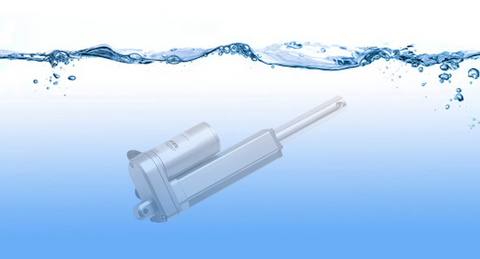
Home automation isn’t limited to just indoor applications and many uses of linear actuators require them to be exposed to the elements. But is that safe? The answer to that question is that it depends on the actuator. So, how do you know if your linear actuator is waterproof? And what does it mean to be waterproof? These are just a few of the questions this blog will aim to answer to help you find the right linear actuator for your next project.
Waterproof or Water-Resistant?
When you shop for household electronics you will often see products referred to as waterproof or water-resistant. However, what does it mean to be waterproof or water-resistant? Do they mean the same thing? The answer to the latter question is no, there is a difference between being waterproof and water-resistant. Waterproof refers to the inability for water to enter the internal components of a device, while water-resistant refers to the device’s ability to protect against water entering the device during a certain duration and situation. Most consumer electronics, like smartphones, are water-resistant, even if they are marketed as waterproof [1]. For linear actuators though, you can find both waterproof and water-resistant linear actuators as some industrial actuators are design specifically for underwater or very wet applications. But how do you know that your linear actuator is waterproof or water-resistant? That’s where the IP rating comes in to play.

How to Tell if your Linear Actuator is Waterproof or Water-Resistant?
When you want to determine whether or not your linear actuator is waterproof or water-resistant, you’ll want to look up your actuator’s Ingress Protection (IP) rating. The IP rating system was developed by the International Electromechanical Commission and is used to describe the level of protection an enclosure provides to electrical equipment [2]. IP ratings are used to classify the level of protection of a wide range of products from linear actuators to smartwatches. Typically, you will see the IP rating written as IPXX where the XX are two numbers, like seen in the IP rating guide below this paragraph. The first digit refers to how well the enclosure protects the internal electronics from solids. This rating ranges from 1, protects against solids larger than 50mm, to 6, completely protects from dust particles [2]. You’ll need a higher solids IP rating in applications where there will be lots of dust and debris, like in industrial uses.

More relevant to this discussion is the second digit, which refers to how well the enclosure protects the internal electronics from liquids [2]. This digit will tell us if our linear actuator is waterproof or what level of water-resistant it is. On the lower end of the rating, the enclosure will only protect from water droplets from various angles; 1 meaning only protecting from vertical droplets, 4 meaning protection from splashes of water from all directions. IP liquid rating of 5 or 6 means the enclosure can protect from more high pressure water jets with IP rating of 6 also protecting against saltwater. A rating of 7 means the enclosure can be completely submerged for 30 minutes at a depth between 15cm to 1m. An IP rating between 1 and 7 would mean your linear actuator is water-resistant to varying degrees. For a waterproof linear actuator, you would be on the lookout for an IP liquid rating of 8 as these enclosures will protect against the effects of submersion at higher pressures for long periods of time [2].
Unless you plan to use your linear actuator underwater, you probably don’t need an actuator with an IP liquid rating of 8. Generally, for any outdoor application, a rating between 5 and 7 is sufficient to protect the internals of the linear actuator. But if you want to be sure, you can use the IP rating guide above to judge if your chosen actuator has the level of protection you need for your application. Just remember that the IP rating is for the enclosure and not the bare wires you use to power and control your actuator. You’ll still need to ensure the rest of your design will be protected from the level of water your application will experience.
References
- Patkar, M. (2016, July) What Makes a Device Waterproof or Water-Resistant? Retrieved from: https://www.makeuseof.com/tag/makes-device-waterproof-water-resistant/
- Bohn, R. (2013, August) IP Ratings Explained. Retrieved from: https://www.nemaenclosures.com/blog/ingress-protection-ratings/
IP Rating Guide from: https://www.nemaenclosures.com/blog/ingress-protection-ratings/